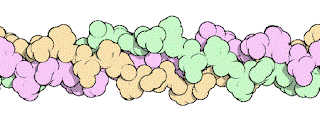Proteins
Amino acids>
Monomers of all proteins, all have the same basic structure.
Peptide bond>
A bond formed when two amino acids are joined by a condensation reaction.
Proteins are polymers comprised of long chains of amino acids. The properties of proteins give them a variety of functions:
They form components of animals, ie. muscle tissue
Adopt specific shapes- enzymes, antibodies and some hormones.
Membranes have protein constituents that act as carriers and pores for active transport across the membrane and facilitated diffusion.
Both plants and animals need amino acids to make proteins. Animals can make some proteins, but must ingest others, (essential amino acids).
 |
| Structure of Collagen |
Structure of an amino acid>
Each 'R Group' has a different and specific characteristic.
Cysteine has sulphur in its R Group so it forms strong covalent S-S disulphide bonds.
Peptide bonds join amino acids together.
2 amino acids join to form a dipeptide.
Primary Structure>
Peptide bonds formed between amine of one amino acid and combines with the OH carboxyl group of another amino acid.
This is a condensation reaction, where water is produced.
The peptide bond is covalent.
Secondary Structure>
Alpha helix or beta pleated sheet is formed from the primary structure due to the formation of hydrogen bonds between the amine group of one amino acid and the carboxyl group of another a short distance away.
Tertiary Structure>
Some R groups attract/repel.
Disulphide bridges/bonds form between cysteine/SH groups/S atoms.
Hydrogen/H bonds very important.
Ionic bonds also form between oppositely charged (+ and -) R groups and side chains.
Hydrophilic R groups arrange themselves on the outside of the protein molecule/in contact with water molecules whilst hydrophobic R groups are shielded from water molecules on the inside of the molecule.
Quaternary Structure>
The structure formed when two or more polypeptide chains join together, sometimes with an inorganic component, to form a protein.
 |
| Haemoglobin |




Huwentoxin-XVI, a 39 amino acids peptide, is potent and selective N-type Ca2+ channel blocker (IC50 ~ 60 nM). It can selectively and reversibly block N-type Ca2+ channels, but it does not block T-type Ca2+ channels, K+ channels or Na+ channels. It shows analgesic effects in vivo. Huwentoxin XVI
ReplyDeleteny style pizza greensboro nc At Moe's we believe that life is better with pizza. We are a fast-casual restaurant serving handcrafted pizzas, fresh salads, and decadent desserts. Order online for carryout or delivery today!
ReplyDelete